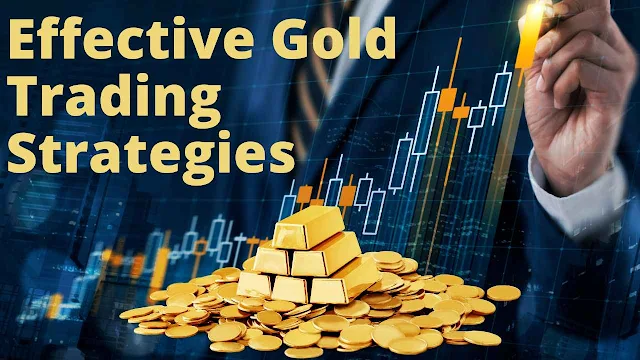Effective Gold Trading Strategies | Insights from Professional Traders. Looking to navigate the intricate world of gold trading effectively? Dive into the exclusive realm of gold trading strategies with insights from seasoned professional traders.
Gain a comprehensive understanding of the dynamic landscape of gold trading, from essential tips and tricks to advanced techniques that can boost your trading portfolio.
Whether you're a seasoned trader seeking to enhance your strategies or a newcomer eager to grasp the fundamentals, this article is your ultimate guide to maximizing your success in the exhilarating gold trading market.
 |
| Effective Gold Trading Strategies |
Gaining Insights into Gold Technical Analysis from Professional Traders
Experienced fund managers employ a variety of technical, fundamental, and emotional indicators to predict the future trajectory of gold prices.
Gold, known as the "yellow metal," is a unique asset, serving both as a precious metal and an industrial commodity. It is commonly quoted in US dollars and is traded on various markets, including exchanges and over-the-counter platforms.
Using Technical Analysis for Gold ETF Trading
- When investors seek refuge from weakening currencies, gold is often viewed as a safe haven asset whose value tends to rise. As global interest rates decline, the demand for a currency that retains its value contributes to higher gold prices. Gold is traded in currency markets, futures markets, and forward markets.
- The GOFO rate, associated with gold, is analogous to the rates for the US dollar and the Euro. When gold's interest rate increases, this financing cost rises as well. The Gold Forward Offer Rate, more precisely, represents the rate at which gold is borrowed in the market against the US dollar, using gold as collateral, potentially at a lower interest rate than otherwise required.
- Investment professionals, traders, and speculators assess three key elements that shape their view of the gold market: technical data, fundamental factors, and sentiment.
Technical Analysis of the Gold Market
- Experienced investors often study a weekly chart to understand the long-term trends in gold prices. Gold, like other financial assets, follows price patterns and often trades within a sideways range. By using various techniques, it is possible to determine whether the price is likely to remain stable or experience fluctuations.
- As of August 2021, gold futures prices have exhibited a steady decline on a weekly basis while maintaining a sideways trend in comparison to the 50 and 10 Weekly Moving Averages.
- The MACD (moving average convergence divergence) chart displays bearish signals, and the proximity of the moving averages suggests a balance of power. Moreover, the indicator hints at the potential for increased strength.
Emphasizing Momentum
- The Relative Strength Index (RSI) is a widely used momentum indicator that measures the speed of price movements over a 14-day period.
- Since reaching its peak in the week of August 7, 2021, the RSI for gold has been trending downward. Currently at 57.56, with a high of 80 and a low of 40, it indicates a balance between buyers and sellers with a slight bias towards the downside. Bullish traders are looking for the RSI to cross the 60 level, which would suggest a shift in favor of the upside.
- Analyzing previous RSI highs can help in capitalizing on market trends. Historical data shows that the weekly RSI has reached levels of 92, 77, and 75, indicating that the momentum can still go above the 70 threshold as gold prices surge.
Assessing Market Sentiment
- Market sentiment surrounding gold is constantly changing and can be influenced by various factors, including economic news, geopolitical events, and supply and demand dynamics. Monitoring sentiment can help investors identify opportunities in the gold market.
- One of the most influential indicators for gauging sentiment is the Commitment of Traders (COT) report provided by the Commodity Futures Trading Commission (CFTC). This report offers valuable insights for traders to understand market dynamics.
- The COT report provides data on positions, categorized into trade sellers, managed funds, and other categories. Trade sellers may include banks and companies specializing in the industry, while managed funds encompass speculative investments, pensions, and mutual funds. Retail traders are considered another category.
- The CFTC doesn't specify the motivations behind these positions, but analysts focus on whether positions are increasing or decreasing, which can provide important clues.
- In general, trade vendor positions are believed to result from transactions with gold producers and refiners and are offset by virtual positions managed by managed money.
- Examining this data reveals two key concepts for sentiment analysis. First, the pattern establishment indicates whether large speculators are increasing their long positions (positive sentiment) or shorts (negative sentiment). Second, examining the extreme levels of long and short positions in managed funds can help gauge sentiment and potential price movements.
Fundamental Factors Affecting Gold
- Two crucial indicators for gold's performance are US Treasury yields and the direction of the US dollar.
- Higher borrowing costs make gold less attractive, as it doesn't generate interest or income. In a period of low interest rates (such as 2021-2022), gold becomes more appealing as an asset. Higher borrowing costs or deposit returns increase the cost of storing non-interest-bearing gold.
- When the US dollar strengthens, gold becomes more expensive in other currencies, leading to lower gold prices. Conversely, a weaker dollar has the opposite effect.
- In conclusion, trading gold requires a comprehensive understanding of technical, fundamental, and sentiment analysis, along with a grasp of the factors affecting its price movements.
Take action on climate change
Climate change has wide-ranging effects, from disrupting ecosystems to harming human health.
This issue is not limited to the present but is a concern for the future, with worsening consequences if no proactive measures are taken.
To combat climate change, efforts must focus on reducing greenhouse gas emissions and minimizing damage.


Comments
Post a Comment